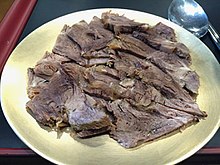
Back Phjonjuk Hungarian Pyeonyuk ID Pyeonyuk JV 편육 Korean Pyeonyuk Malay Пхеньюк Russian Pyeonyuk Turkish Pxenyuk Uzbek 片肉 ZH-YUE
 Beef pyeonyuk | |
| Place of origin | Korea |
|---|---|
| Associated cuisine | Korean cuisine |
| Serving temperature | 15–25 °C (59–77 °F) |
| Main ingredients | Beef (brisket, plate, foreshank, tongue, testicle, mammary, head, liver, spleen, trotters) or pork (belly, head, trotters) |
| 42.5 kcal (178 kJ)[1] | |
| Korean name | |
| Hangul | 편육 |
|---|---|
| Hanja | 片肉 |
| Revised Romanization | pyeonyuk |
| McCune–Reischauer | p'yŏnyuk |
| IPA | [pʰjʌ.njuk̚] |
 |
| This article is part of a series on |
| Korean cuisine 한국 요리 조선 료리 |
|---|
Pyeonyuk (Korean: 편육; Hanja: 片肉) is a traditional Korean dish, which consists of thinly sliced meat that has been boiled and pressed.[2] Either beef or pork may be used to make the dish.
It is eaten as anju (an accompaniment to alcoholic drinks), or used as a topping for other dishes such as naengmyeon (cold noodles) and seolleongtang (ox bone soup).[3] In the past, pyeonyuk was made during the preparation of a large amount of beef stock or broth for various dishes served during feasts and banquets.[4] Today, it is also used in non-traditional dishes, such as a cold cut in wrap sandwiches, and is considered to be a healthier alternative to deep-fried, stir-fried, or roasted meat.[3]
- ^ "Yangji-meori-pyeonyuk" 양지머리편육. Korean Food Foundation (in Korean). Retrieved 5 July 2017.
- ^ "Main meals/Side dishes". Food in Korea. Korea Agro-Fisheries Trade Corporation. Archived from the original on 14 April 2009. Retrieved 17 May 2008.
- ^ a b Lee, Jon-im (Spring 2011). Lee, Kyong-hee (ed.). "Pyeonyuk: Sliced Beef". Koreana. Vol. 24, no. 1. pp. 76–79. Retrieved 5 April 2013 – via issuu.
- ^ 주, 영하 (5 July 2011). "[주영하의 음식 100년](18) 편육". Kyunghyang Shinmun (in Korean). Retrieved 5 July 2011.